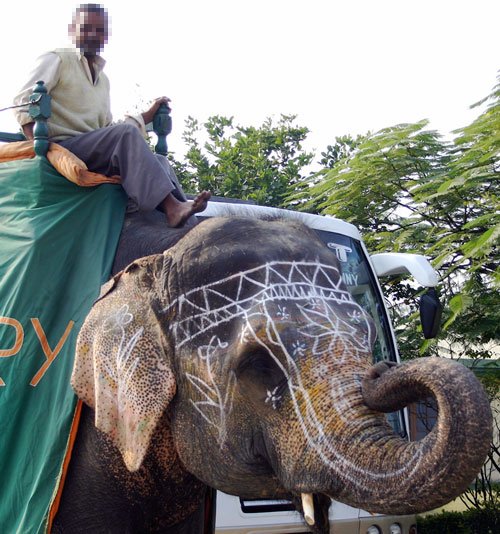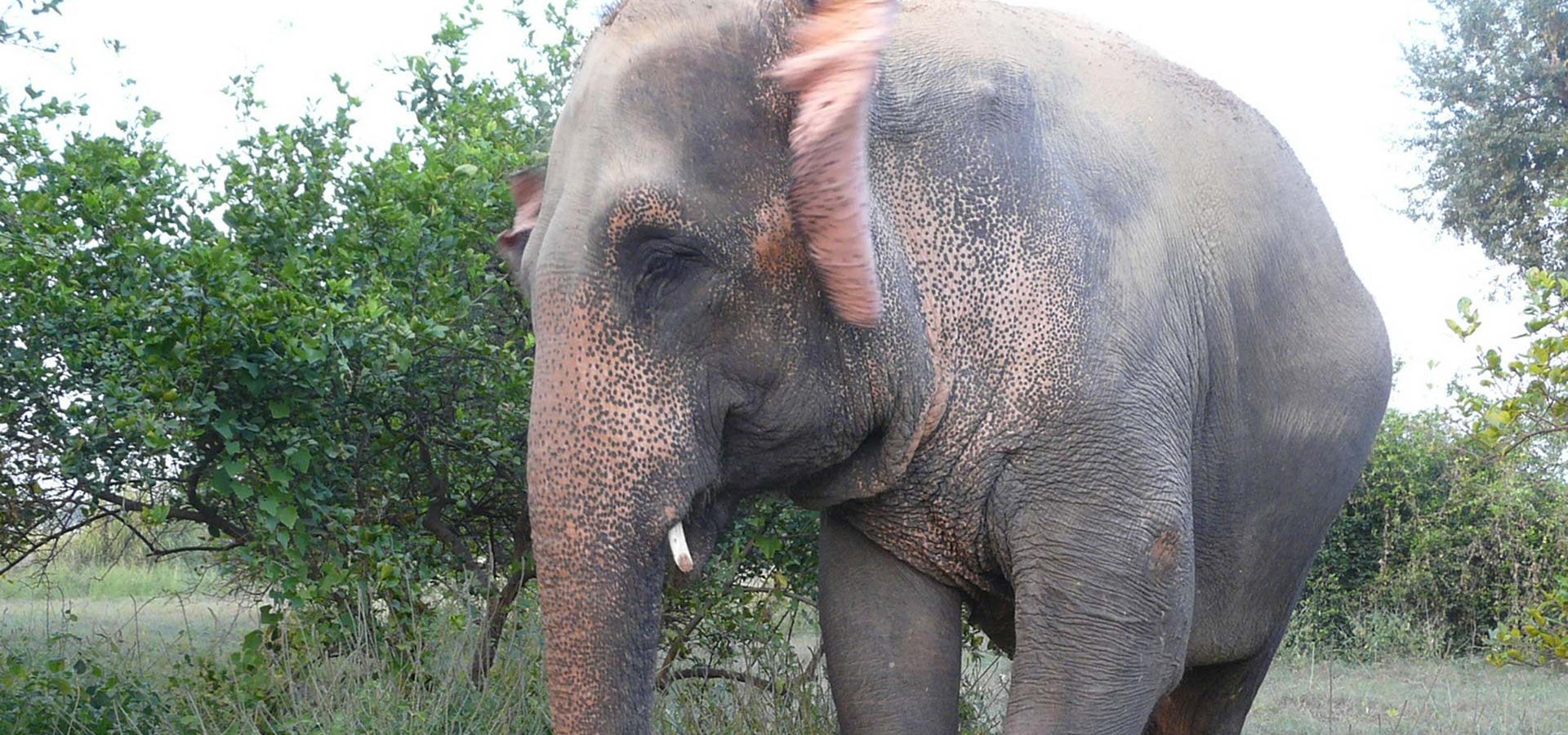It was nine years ago when we first saw Champa (Hindustani for Jasmine). She walked at a painfully slow pace on the scorching tarmac on a very hot summer day on the Delhi Agra Highway. As she uncomfortably lumbered into a small hotel just off the bustling free way, she clearly seemed to be in agony. She was limping and a closer look showed an inflamed foot pad and an old suppurating injury. Our friendship was cemented at that very moment. She was a beautiful Asian Elephant, gentle and patient, but she was obviously in need of help!
Our Animal Ambulance started visiting Champa regularly to provide her veterinary care including medicated foot baths for Champa’s feet to help reduce her massively swollen and injured footpads. The injuries were further exacerbated by the constant work of carrying tourists for rides on tarred roads in dry hot summers of Uttar Pradesh; attending marriage functions and religious ceremonies which involved standing in the sun for long hours!

Over the years we saw Champa go through a lot: a particularly nasty abscess on her elbow; and another on her rump; inflamed foot pads and severe dehydration at times. Her owner, who used Champa to earn what he could to provide for his family, used traditional medication, but it clearly wasn’t enough and didn’t work to reduce her pain or cure her.
We worked very hard to forge a friendship with Champa and her mahout, who was grateful that we were there to help. He never hesitated to call us when she needed help. But over the last year, her condition sadly began to deteriorate rather quickly. The tourist visits were less frequent and the mahout saw his financial situation worsen. With barely enough to feed his family, providing proper food and care for Champa was a luxury that he couldn’t afford. She needed large amounts of green fodder (about 400 kilograms each day) in addition to constant veterinary care and lots of rest without having to walk on hot tarmac. Because he couldn’t earn from tourists the mahout started walking her further and further away to secure work to earn money to feed her. She would often have to walk for 2 -3 days to attend a wedding or an event that would earn her mahout some money.

¨Each time we drove to the Bear Sanctuary, we would stop and meet Champa but then she was missing for several months. We were alarmed, but when finally Champa was back our old friend was clearly in pain from a giant abscess in her foot. Knowing how dangerous this situation was, our veterinary doctors rushed to check on her immediately and spent the next few weeks changing bandages, cleaning and irrigating the wound as best as they could. Her care was supplemented with antibiotics and tonics; gradually she started showing signs of improvement and could walk slowly around the garden. Alas, with his own needs to fulfill, the moment Champa started recovering, her Mahout had her back on the road so he could earn money from her. You can only imagine the heartbreak that we all felt over this development.
We had tried for years to rescue her but elephants are expensive! Even if we could find the land to build an appropriate area for her convalescence, the costs associated with daily care for an elephant are astronomical.
Thankfully, When there is a will, there’s a way!
With invaluable and generous support from our friends – HSI Australia, Joan Pearson and One Voice France we were able to raise the initial funds required to start Champa’s rescue process! We managed to raise funds to rent land and create a safely fenced off area for Champa! A large truck, two mahouts, two drivers, several staff and some days later Champa was finally at her new home! She now had nearly four green acres of land to herself; a large clump of shady trees and greenery where she could spend the rest of her life painlessly in peace and dignity. We allowed her to acclimatize herself to her happier new surroundings and her mahout was quite relieved to find himself employed as her caretaker, especially since we noticed that Champa likes her mahout.

Once she settled down in her new surroundings she underwent a thorough veterinary examination. Footpads and a full body check, immunity level checks, extensive Blood tests, Tuberculosis tests etc were carried out. Thankfully she tested negative for tuberculosis however she was showing signs of senility from her long, hard life of servitude. Her heart showed signs of stress; she had very low calcium levels. A smashing good diet with lots (read: hundreds and hundreds of Kilograms) of fruits, tonics, grains, and green fodder was a quick way to help improve her health. The Wildlife SOS vets quickly put together a healthy and nutritious high protein diet to help speed up her recovery. But she had lived so long without nutritious food she would turn her trunk away at the sight of such wonderful food! Alas “ Cooked rice or wheat porridge would have to be the base for her meals. Sweetened protein additives such as rose petal jam along with minerals, vitamins and other tonics helped to get her back on track. Champa was fortunately a big fan of coconuts, water melons, bananas and mangoes and we ended up hiding her medicines inside her food.
Addressing the nutritional issues systematically went a long way to helping her regain her energy. Truckloads of fruits later, we can actually see her skin color gradually change from a dull dry grey to a glistening black with pink patches typical of the Asiatic elephant and the twinkle returning to her tired, tear-stained eyes.
Champa is remarkably patient as the vets clean up her wounds and injuries. Several bottles of antibiotic cream are applied daily to help deal with her skin injures. Fly repellent keeps flies away so she can enjoy her daily footbaths! Her deep sighs of joy and little grunts tell us that she enjoys the relief.
We have been able to build her a large shelter and a nice large pond that she can now use to enjoy her retired life. Playing with water is Champa’s main joy these days. Champa can now have a quality of life that she has never known before. Her time was running out and we are delighted at having been able to rescue her and save her from the worst possible fate.
Geeta Seshamani of Wildlife SOS says, ”We are grateful to the Uttar Pradesh Forest Department for their support and cooperation. While we are very happy that we are able to give her this wonderful life, its a huge
responsibility we have taken on. We need to be able to guarantee her all the help she requires. We hope to create an education unit here to train mahouts about elephant care. Who can be a better example than Champa of how a loving hand works better than the ankush?”
Kartick Satyanarayan co founder of Wildlife SOS says, ”We are very grateful to our dedicated friends at One Voice France, HSI Australia, and Joan Pearson who made it possible for us to rescue and give Champa immediate freedom and dignity. Champa will live for several years more and we need to create a safety net for Champa’s long term rehabilitation, welfare, treatment and care. We also need to put in additional infrastructure and support systems in place to ensure her long term care and support. We also hope to rescue two more elephants soon who are in a similar situation and are in agony now.”





